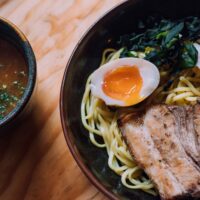Ramen is more than just a simple bowl of noodles; it’s a culinary experience steeped in history and tradition. This beloved dish has traveled from its roots to become a global phenomenon, captivating the taste buds of food enthusiasts worldwide. From its humble beginnings to the intricate flavors that define it today, ramen is a dish that holds many mysteries waiting to be unveiled. In this article, we will dive into the rich history of ramen, explore the key ingredients that give it its distinctive character, delve into regional variations, and appreciate the artistry involved in its preparation.
The Rich History of Ramen
Ramen’s origins can be traced back to China, where it began as a simple wheat noodle soup. It is believed that the dish made its way to Japan in the late 19th century, brought by Chinese immigrants. The Japanese quickly embraced ramen, adapting it to their local tastes and ingredients. Over the years, ramen evolved, with each region of Japan developing its unique version of the dish. The post-World War II era marked a significant turning point for ramen, as it became a staple in Japanese cuisine, thanks in part to its affordability and comforting nature.
The 1950s saw the invention of instant ramen by Momofuku Ando, revolutionizing the way people consumed this dish. Instant ramen brought convenience without sacrificing flavor, making it a household favorite globally. Despite its modern adaptations, traditional ramen shops, known as ramen-ya, continue to thrive in Japan, preserving the authentic flavors and methods of preparation.
Key Ingredients That Define Ramen
The complexity of ramen lies in its carefully selected ingredients, each playing a crucial role in creating its rich and layered flavors. At the heart of ramen is the broth, which can be categorized into several types:
- Shoyu (Soy Sauce): A clear, brown broth flavored with soy sauce, offering a balance of savory and tangy notes.
- Miso: A thicker, creamier broth made from fermented soybean paste, providing a robust and hearty flavor.
- Shio (Salt): The lightest of all broths, shio ramen features a clear and delicate taste, often enhanced with chicken or seafood.
- Tonkotsu: A rich, creamy broth made from pork bones, slowly simmered to extract maximum flavor and gelatin, creating a velvety texture.
Equally important are the noodles, which vary in thickness, texture, and flavor. Fresh, handmade noodles are often preferred for their superior texture and ability to absorb the flavors of the broth. Ramen toppings further enhance the dish, with common options including:
- Chashu (Braised Pork): Tender slices of pork belly, marinated and slow-cooked to perfection.
- Menma (Bamboo Shoots): Fermented bamboo shoots adding a crunchy texture.
- Nori (Seaweed): Sheets of dried seaweed providing a unique umami flavor.
- Ajitama (Marinated Egg): Soft-boiled eggs marinated in a soy-based sauce, with a creamy yolk center.
These ingredients, when combined, create a symphony of flavors and textures that define the essence of ramen.
Regional Variations and Their Unique Flavors
Japan’s diverse landscape has given rise to various regional ramen styles, each with distinct characteristics. Sapporo, located in Hokkaido, is renowned for its miso ramen, which features a rich, hearty broth complemented by butter and corn. This style is perfect for the region’s cold climate, offering warmth and sustenance.
In contrast, Hakata ramen from Fukuoka in Kyushu is famous for its creamy tonkotsu broth, made from pork bones simmered for hours to achieve a silky consistency. The noodles in Hakata ramen are typically thin and firm, providing a delightful contrast to the rich broth.
Tokyo-style ramen often features a soy-based shoyu broth, which is clear and savory. The noodles are usually medium-thin and curly, holding up well in the lighter broth. This style of ramen is a reflection of Tokyo’s bustling urban environment, offering a quick yet satisfying meal.
Each regional variation of ramen tells a story of its place of origin, showcasing the adaptability of this dish and its ability to incorporate local ingredients and preferences.
The Art of Ramen Preparation
Crafting the perfect bowl of ramen is an art form that requires skill, patience, and a deep understanding of ingredients. From the selection of the broth base to the precise cooking of noodles, every step in the preparation process is crucial. The broth, often simmered for hours or even days, must achieve the right balance of flavors and consistency. Chefs meticulously monitor the temperature and ingredients to extract the maximum umami.
Noodle making is another critical aspect, with many ramen chefs preferring to make their noodles in-house. The dough is kneaded to the perfect elasticity, rolled out, and cut to the desired thickness. Cooking the noodles requires precision; they must be boiled to achieve the ideal firmness without becoming too soft.
Toppings are prepared with equal care, from the slow-cooked chashu to the marinated eggs, ensuring they complement the broth and noodles. The assembly of the bowl is the final step, with each element carefully placed to create a visually appealing and harmonious dish.
The art of ramen preparation is a testament to the dedication and passion of ramen chefs, who strive to provide an unforgettable culinary experience with every bowl.









